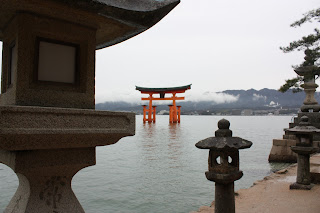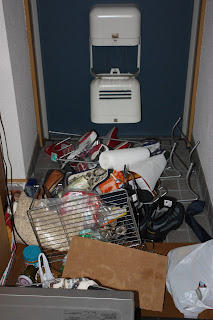After the earthquake, my kouchou-sensei (principal) allowed me to have three days oyasumi (absence), as I had no work for the remaining six now-half days of the school year. At first, the days at home seemed to be a good idea. However, the aftershocks were still quite strong and frequent; and I discovered that staying home alone was far less preferable to sitting at school with nothing to do. So when my friends, R.D. and A.D., invited me to stay with them in Yokohama over the holiday weekend as well as go with them to Hiroshima for a couple of days, I jumped at the chance to use my last two days of nenkyuu (vacation) to get out of town. And, thankfully, my kyoutou-sensei (vice-principal) was more than willing to let me go. While I didn’t get as much rest as I would have liked, I was able to relax and enjoy myself.
My time in Yokohama was so nice and, now that I think about it, centered almost entirely on food, as there is an abundance of American-style and American chain restaurants scattered throughout Yokohama. But I was so stuffed from my four days of American food gluttony (I forgot the
lesson that I learned on Guam about American portion sizes.) that I’m now inspired to eat only when hungry and to eat like Okinawans, who eat until they’re 80% full and then stop.
It was also great to discover that my friends and I travel well together. In traveling to/from and around Hiroshima, we moved at the same pace. (It helped that, at 5’9”, I’m the shortest of the three of us. However, it didn’t help in avoiding stares.) We were interested in seeing the same things. We got hungry at the same time. ☺ And we weren’t distraught when we ran out of time to see the Peace Memorial Museum before having to catch our Shinkansen (bullet train) back to Yokohama. So A.D and I are talking about when we might be able to travel back to see the museum. Here are some pictures from the Peace Memorial Park, with captions synthesized and quoted from the literature provided throughout the park:
A-bomb Dome: On August 6, 1945, at 8:15 a.m., an American B29 bomber dropped an atomic bomb approximately ¼ mile above and 1½ football stadiums away from the Hiroshima Prefectural Industrial Promotion Hall. The building was almost completely destroyed by the resulting fire, causing everyone in the building to perish immediately. As time passed, the former promotion hall became a hazardous, derelict, and painful reminder of what happened during the war. So many wanted the ruins to be razed. But as the city was rebuilt and other buildings that had been destroyed by the bomb were cleared away, others began to advocate the preservation of the promotion hall. The first such project occurred in 1967, funded by Japanese and foreign donations, with several additional projects following in later years to guarantee that the promotion hall, renamed the A-bomb Dome, would forever look as it did following the bombing. In 1996, the A-bomb Dome was registered with the World Heritage List “as a universal peace monument appealing for the abolition of nuclear weapons and the realization of lasting world peace.”
Memorial Tower to the Mobilized Students: Over three million students over the age of 12 were mobilized to work throughout Japan during WWII. More than 10,000 of these students were killed, including 6,000 by the A-bomb.
"This tower was erected by concerned families and friends to console the souls of these victims who sacrificed themselves for their homeland, and who would have had a promising future had there been no war."
For those who died and those who cried: Japanese legend holds that if a person folds one thousand
origami cranes, his or her wish will be granted by a crane, a traditionally holy creature. These cranes are hanging at the memorial tower.
Children’s Peace Monument: “This monument stands in memory of all children who died as a result of the atomic bombing of Hiroshima…. Built with contributions from more than 3,200 schools in Japan and donors in nine countries, the Children’s Peace Monument was unveiled on May 5, 1958.
“At the top of the nine-meter (27-feet) monument, a bronze statue of a young girl lifts a golden crane entrusted with dreams for a peaceful future. Figures of a boy and a girl are located on the sides of the monument.
“The inscription on the stone block under the monument reads: ‘This is our cry. This is our prayer. For building peace in this world.’…”
A one thousand crane
origami mural at the peace monument whose
kanji read “Peace”.
While in Hiroshima, we also visited Miyajima Island which lies off the coast. I'll include pictures from that portion of the trip in another post.
Until next time…

















